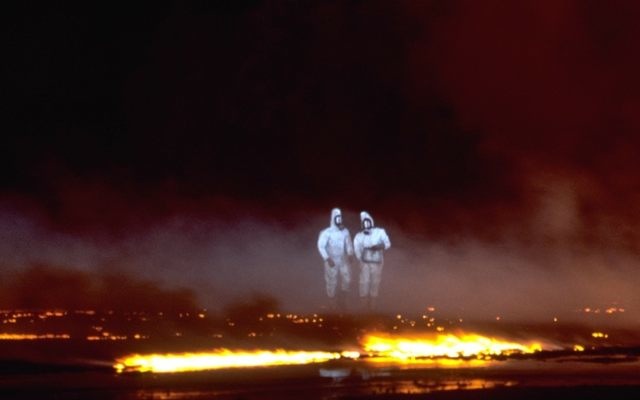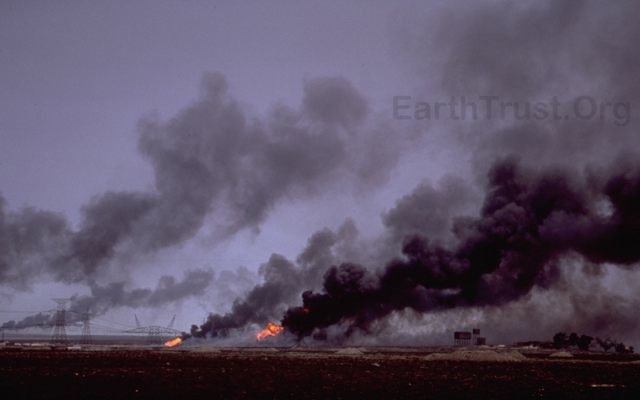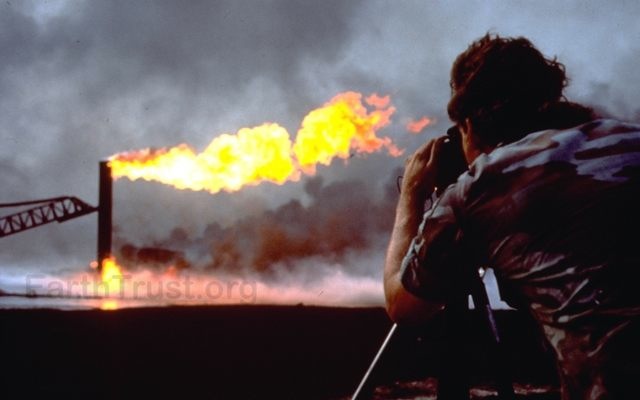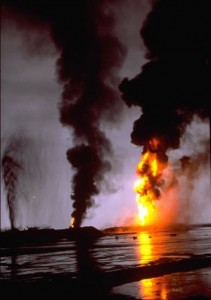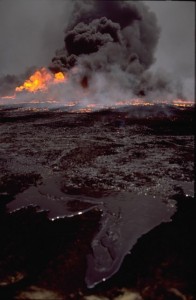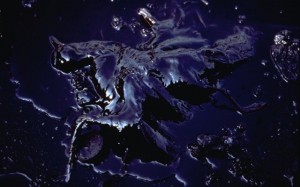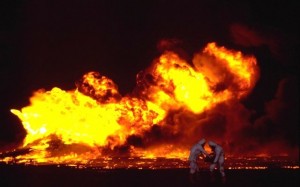Mission: Break the Deadlock in capping the Kuwait oil fires
The petrochemical hell of burning Kuwait oilfields was going to go on for years. That was unacceptable.
In 1991, the environment was used as a weapon of war.
In the summer of 1990, Iraq’s Saddam Hussein launched a war to occupy Kuwait, and in 1991 a US-led coalition drove his forces out. Everyone knows about it; you can get great details about the conflict on Wikipedia. But there is an expanded story to tell about the environmental response, and that’s our impossible case history here.
Political considerations aside, Saddam Hussein loosed a petrochemical hell in the wake of his retreat. More than 600 producing oil wells were blown up and set afire. Hussein’s troops had dug trenches and laid pipes dumping oil into the gulf, to set trenches afire and foul the water. And aside from the various militaries, nobody knew this, because in the wake of the destruction no international media were being allowed into Kuwait. They were being sequestered in Bahrain, with no way to report first-hand on the aftermath of the war.
Moreover, political-corporate deals had been struck between the U.S. administration, the UK administration, and the Kuwait royal family. Unbeknownst to the world, there was no plan to quickly clean up the mess. Indeed, there was a plan not to. All work snuffing oil-well fires and protecting the environment would only be allowed to be done by US, UK, and Kuwait firms. Inasmuch as neither the UK nor Kuwait had any firms with expertise in dealing with blown-up oil wells, this meant that the 3 or 4 US firms would have a long slow slog of it, with one or two UK and Kuwait startups learning the ropes. It was predicted that snuffing the fires and capping the wells would take 2-3 years.
Moreover, the instructions by Kuwait’s Emir were as clear as they were terrible: do no work to stem the fire and flow of any well until the previous well you have worked on is actually producing again. If followed, this could add another year or more to the timetable. It was an edict scarily detached from physical reality. Yet absent images of the disaster on global TV news, there was no international outcry to do otherwise.
OK, so how did EarthTrust know this stuff when the rest of the world didn’t? Well, that sort of thing tends to happen. In this case, it was due to the fact that as soon as the missiles started falling, EarthTrust sent scouting teams into the war zone, including combat veterans with munitions experience. While the international media were cooped up in Bahrain, ET staffers were going through mine fields, shutting off oil valves, and coordinating on-the-ground response to the environmental crisis.
But hold on a minute… ET is a group that saves dolphins and whales, right? Well, and endangered species. Why in the world did it deploy into a burning middle-east war zone from its pacific headquarters?
Well, it’s because very few organizations understand how to operate in chaotic conditions, and that’s very apparent. Huge progress can often be made in a short time when normal rules don’t apply. (Nassim N. Taleb has just written a great book called AntiFragile, highly recommended, but no news to ET. Similar points are made in Klein’s “Shock Doctrine”, except for the ET corollary that good guys can use the same tactics).
So what was ET able to do? In addition to directly deploying barriers to keep oil out of the gulf, and shutting down Saddam’s gushing oil pipelines, the ET crew was able to take partial control of the situation. Setting up in the lobby of the Kuwait Hilton with a 50mm Russian machine gun mounted on the desk to get attention, ET created the Gulf Emergency Response Team, and became a main non-military center for information and intelligence. That is, by stepping up, authority was created and progress started to happen.
ET campaigners handling the gulf environmental response became the main image in global video, film and print media, as ET shut down gushing oil, deployed barriers to protect wildlife, and helped local people.
Soon ET became the mechanism to get world media to the oil fires. While the top echelons of the US military were restricted by politics, the lower-level officers actually fighting the war responded powerfully to the ET presence and expertise. Soon ET was scheduling helicoptor flights from Bahrain to Kuwait, where ET staffmembers would walk them through the minefields and provide statements. Anyone watching TV about the environmental disaster anywhere in the world saw pictures of ET staffmembers, and most carried interviews by ET field workers as their main content because there was nobody else there to interview.
A lot of risks had to be taken. ET field campaigners drove through walls of fire, defused explosives, recovered information from buildings with live explosives set, and had many Iraqi’s try to surrender to them.
Of course, well before ET was able to get the international media into the nation, ET was shooting its own video documentary, for a very special audience: The Emir of Kuwait and his ranking family members, who received a special showing. ET’s campaign goal was to press Kuwait to open up the fire-snuffing and environmental-cleanup work to international teams, to bring the pollution more quickly under control than the many-years timetable which was the then-current plan.. and to throw out ridiculous edicts like “quench no fire until the previous well is producing”.
The ET campaign succeeded, helped along by the beginning of a world response to the devastation, generated by the first international media crews ET got to the burning fields and lakes of oil. After the official policy changed, many innovative new techniques were tried, such as a Russian crew with a MIG fighter engine mounted on a tank to blow out the oilwell fires. The wells were all capped in a matter of months. It’s estimated that opening the well-capping to international teams prevented the burning and spillage of 2-5 billion barrels of oil.
There’s utterly no question this was an EarthTrust win. We’re all over the historical images. And now you know it was the same group that has done a lot of other cool stuff.
So really, why did ET do this?
Simply because it was fairly evident that (1) it needed doing, and (2) there really and truly was no other such group anywhere who would. (Seriously; if there was, where were they?) If you see a person drowning and you’re the only one around who knows how to swim, the onus is on you to try saving them.
In this case, the impossible mission was solved with equal measures of expertise and audacity: the ability to operate politically and militarily in chaotic conditions. The undercover and field-campaign work done by ET on other issues meant that when an environmental crisis broke out on the other side of the world, it was reasonable for us to sit down and discuss whether we should go try to fix things. That’s really what it came down to. What it often comes down to.
Maybe you should be in those discussions with us.
Funny, interesting, and ironic side-stories.
This one may be funnier to you than it was to us. ET didn’t have the funds to do a long-term campaign, but after it had set up the Environmental Response Team and began bringing in international media, it was approached by the remaining representative of Kuwait’s ruling al Sabah family to coordinate the environmental response to the crisis.
Pretty much all the other al Sabah’s had fled the country and were filling luxury penthouses in the major cities of the world. Being in Kuwait was dangerous, after all. So he represented Kuwait’s government and royal family (pretty much the same thing for practical purposes…)
He met with ET and pledged that ET’s expenditures in coordinating the environmental response would be entirely reimbursed. Based on his authority as the official Kuwait government representative, ET accepted this agreement and kept incurring expenses. Clearly the Kuwaiti’s had more money than they could spend, and it was their nation burning, their oil spewing. The amounts we were spending were significant, but were just spare-bulletproof-mercedes money to the house of al Sabah. (do you detect an annoyed tone to this commentary, even years later?)
Ah, but a cultural problem arose. The al Sabah’s brought back their oil workers to the burning fields and told them to go to work producing oil on the few wells not burning. (And there was an edict that no well would be stopped from burning and gushing until the previous wells were back in production. Yow.)
These were low-paid people who had to travel with their families. Thus, they and their children were brought into a petrochemical hell, with children coughing up carcinogenic black goo in the streets that were as dark as night under the oil smoke. It broke the hearts of the ET team members.
The ET campaigners decided to make a humanitarian statement to the international media which went around the world: don’t bring the poor workers and their kids into a deadly situation. Cap the wells and stop the fires and THEN bring back your non-Kuwaiti workers.
This didn’t fly well with the royal family. Not one little bit.
They liked the idea of foreign conservationists saving their oil, but they were furious at the suggestion that their low-pay foreign laborers and families should not get immediately back to work in the Mordor-like conditions which prevailed.
Long story short, once the edicts had changed in response to ET pressure and the wells were being snuffed with international teams, the newly-returning al Sabah’s used the issue of the ET humanitarian statement to renege on the promise of reimbursing ET, though they coquettishly dragged the process of denial out over several years of promising to pay. The ET workers and executives wound up largely paying for the campaign out of their own personal savings, and it wasn’t a cheap one. Mid six figures american. Ouch.
Still, what’s YOUR carbon footprint?
Here’s a rough edit of some Kuwait Campaign footage
illustrating the ET efforts via news stories and field video excerpts. Be prepared to adjust the video volume for the softer-spoken campaigners. This vid was put together as a rough edit right after Kuwait reneged on its pledge to reimburse the organization.
This will be replaced with a longer, edited video, but is included here to give a flavor for the campaign.



